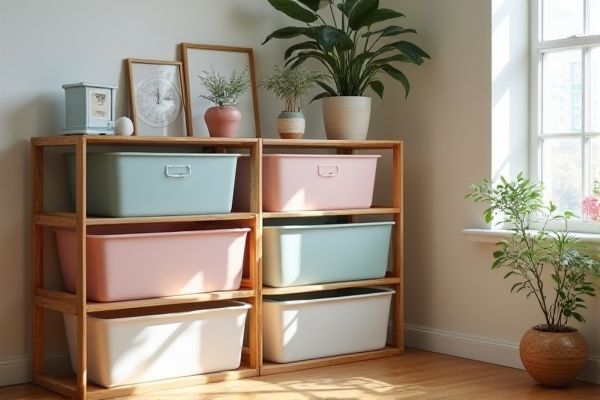
Stackable bins maximize vertical storage efficiency by securely piling bins on top of each other, saving floor space and ensuring easy access. Nesting bins are designed to tuck inside one another when empty, minimizing storage volume and making them ideal for saving space when not in use; explore the rest of the article to determine which bin type best suits your storage needs.
Table of Comparison
| Feature | Stackable Bins | Nesting Bins |
|---|---|---|
| Design | Bins stack securely on top of each other | Bins fit inside each other when empty |
| Space Efficiency | Optimized for vertical storage when full | Maximizes space when bins are empty |
| Usage | Ideal for organized, accessible storage | Best for transport and storage of empty bins |
| Durability | Typically robust to support weight | Durable but may have thinner walls to nest |
| Cost | Usually higher due to reinforced structure | Generally lower cost, simpler design |
| Material | Commonly made from sturdy plastics | Often made from flexible plastics |
| Best For | Warehouse storage, stacking products | Reducing transport bulk of empty bins |
Introduction to Stackable and Nesting Bins
Stackable bins are designed to securely stack on top of each other, maximizing vertical storage space and providing easy access without the need to unstack. Nesting bins fit inside one another when empty, saving floor space and enabling efficient transportation and storage. Your choice between stackable and nesting bins depends on whether you prioritize space-saving during storage or accessibility during use.
Overview of Stackable Bins
Stackable bins maximize vertical storage efficiency by securely stacking on top of each other, ideal for warehouses and inventory management. These bins feature durable construction with interlocking lids or grooves that prevent tipping and allow easy access when stacked. Your organization benefits from optimized space utilization and streamlined order picking with stackable bins designed for stability and accessibility.
Overview of Nesting Bins
Nesting bins are designed to save space when not in use by allowing the bins to fit inside each other, making them ideal for efficient storage and transport. These bins provide versatility for handling and organizing various materials while minimizing wasted space in warehouses or work areas. Choosing nesting bins can improve your facility's workflow by reducing clutter and maximizing available storage capacity.
Key Differences Between Stackable and Nesting Bins
Stackable bins are designed with flat bottoms and reinforced edges, allowing them to securely stack on top of each other, optimizing vertical storage space and enhancing stability in warehouses or workshops. Nesting bins feature tapered sides, enabling empty bins to fit inside one another, significantly saving floor space during storage and transport but offering less vertical stacking strength when filled. The key difference lies in their functionality: stackable bins prioritize efficient use of vertical space for fully loaded storage, while nesting bins maximize space economy when bins are not in use or are empty.
Space Optimization: Stackable vs Nesting Bins
Stackable bins maximize vertical space by securely piling one bin on top of another, ideal for environments with limited floor space. Nesting bins optimize storage when empty by fitting inside each other, reducing bulk and saving warehouse space during transport or when not in use. Choosing between stackable and nesting bins depends on whether the priority is on efficient usage of occupied space or minimizing space when bins are unfilled.
Material and Durability Comparison
Stackable bins are typically made from rigid, high-density polyethylene or polypropylene, offering superior durability and impact resistance for heavy-duty storage needs. Nesting bins, often constructed from lighter plastic materials, prioritize space-saving design by allowing one bin to fit inside another when empty but may sacrifice some strength under heavy loads. Your choice depends on whether you need maximum durability or efficient storage space optimization.
Ease of Use and Accessibility
Stackable bins offer enhanced ease of use with their stable, vertical stacking design, allowing quick access to individual containers without unstacking the entire set. Nesting bins save space by fitting inside each other when not in use, but accessing lower bins requires removing those on top, reducing immediate accessibility. For operations prioritizing rapid retrieval and straightforward handling, stackable bins provide superior convenience compared to nesting bins.
Cost Considerations
Stackable bins typically incur higher costs due to their reinforced design, enabling secure stacking without damage, which is ideal for maximizing vertical storage space. Nesting bins offer cost savings by allowing empty bins to fit inside each other, reducing shipping and storage expenses but often sacrificing durability when stacked full. Budget-conscious businesses must weigh the premium of stackable bins against the lower initial expense and space efficiency of nesting bins based on specific operational needs.
Best Applications for Stackable and Nesting Bins
Stackable bins are ideal for maximizing vertical storage in warehouses, distribution centers, and retail environments where space efficiency and easy access to goods are critical. Nesting bins excel in applications requiring space-saving storage when empty, such as seasonal inventory management, automotive parts organization, and reusable container systems. Both bin types enhance operational workflows, but selecting stackable bins suits high turnover and quick visibility, while nesting bins optimize space when bins are not fully utilized.
Choosing the Right Bin for Your Storage Needs
Stackable bins maximize vertical storage efficiency by securely locking into place, making them ideal for organizing spaces with limited floor area. Nesting bins save space when not in use by fitting inside one another, perfect for seasonal or fluctuating storage needs. Understanding your storage frequency and space constraints helps you choose the right bin to optimize organization and accessibility for your belongings.
 homyna.com
homyna.com